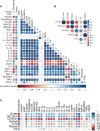A Holistic View of the Goto-Kakizaki Rat Immune System: Decreased Circulating Immune Markers in Non- Obese Type 2 Diabetes
- PMID: 35677049
- PMCID: PMC9168276
- DOI: 10.3389/fimmu.2022.896179
A Holistic View of the Goto-Kakizaki Rat Immune System: Decreased Circulating Immune Markers in Non- Obese Type 2 Diabetes
Abstract
Type-2 diabetes is a complex disorder that is now considered to have an immune component, with functional impairments in many immune cell types. Type-2 diabetes is often accompanied by comorbid obesity, which is associated with low grade inflammation. However,the immune status in Type-2 diabetes independent of obesity remains unclear. Goto-Kakizaki rats are a non-obese Type-2 diabetes model. The limited evidence available suggests that Goto-Kakizaki rats have a pro-inflammatory immune profile in pancreatic islets. Here we present a detailed overview of the adult Goto-Kakizaki rat immune system. Three converging lines of evidence: fewer pro-inflammatory cells, lower levels of circulating pro-inflammatory cytokines, and a clear downregulation of pro-inflammatory signalling in liver, muscle and adipose tissues indicate a limited pro-inflammatory baseline immune profile outside the pancreas. As Type-2 diabetes is frequently associated with obesity and adipocyte-released inflammatory mediators, the pro-inflammatory milieu seems not due to Type-2 diabetes per se; although this overall reduction of immune markers suggests marked immune dysfunction in Goto-Kakizaki rats.
Keywords: Goto-Kakizaki rats; cytokines; diabetes; inflammation; microarrays; obesity.
Copyright © 2022 Seal, Henry, Pajot, Holuka, Bailbé, Movassat, Darnaudéry and Turner.
Conflict of interest statement
The authors declare that the research was conducted in the absence of any commercial or financial relationships that could be construed as a potential conflict of interest.
Figures




References
Publication types
MeSH terms
Substances
LinkOut - more resources
Full Text Sources
Medical
Research Materials

